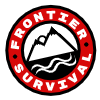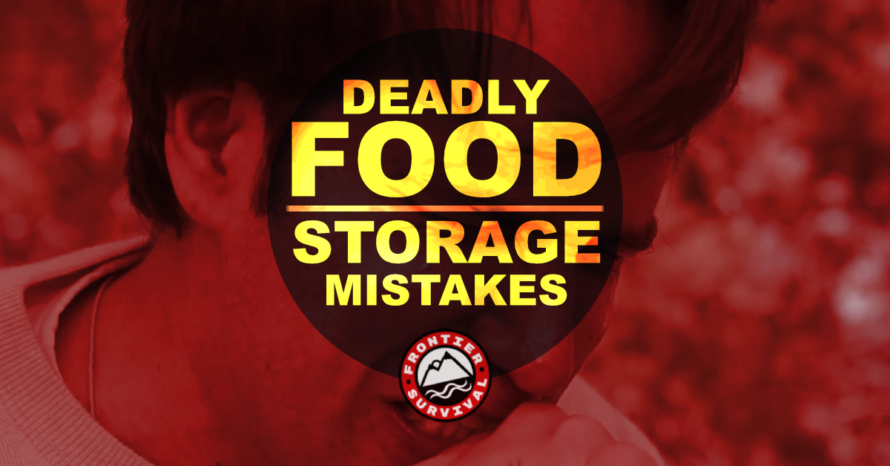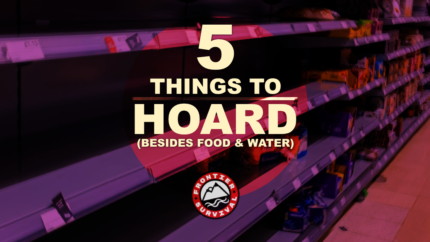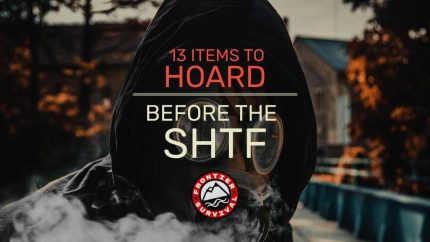When it comes to food and water storage, there are a few common mistakes that a lot of preppers make.
Even seasoned preppers have blind spots, and can sometimes make rookie mistakes.
The reality is that even seemingly minor errors could have disastrous consequences.
After all, your life could literally depend on not bungling it up!
Fortunately, many of these mistakes are easily avoidable.
We’re going to talk about some of the most common food and water storage mistakes that preppers make, and why you MUST avoid them.
Don’t Make These 7 Common (but DEADLY) Food & Water Storage Mistakes…
1. Running Your Big Fat Mouth
The first rule of Prepping is: You do not talk about Prepping.
The second rule of prepping is: YOU DO NOT TALK ABOUT PREPPING.
Third rule of Prepping: Someone yells “Stop!”, goes limp, taps out….
Oops, wrong meeting.
Seriously though, this is important. We put it in the #1 spot for a reason.
Talking about something as common sense as storing extra food and water for an emergency may seem insignificant at the time.
Mentioning your stockpile to co-workers might just seem like fun water cooler chit-chat…
Telling the next door neighbors when you’re cleaning out your basement that you’re making room to store extra food and water may seem like harmless neighborly conversation…
But when times get tough, and food and water is hard to come by, guess who your neighbors or co-workers are going to think about.
That’s right blabbermouth, YOU.

They’re going to think about you and your fancy stockpile of food and water that you’re sitting on.
Don’t expect them to keep it a secret either. Who knows how many people will show up at your doorstep!
Things can, and will, get real ugly in a hurry when people are desperate.
So remember, talking about your preps is like talking to the police…it’s best to just STFU.
Your mouth can get you into a lot of trouble.
2. Buying the Wrong Food
This really should go without saying, but you need to stock up on foods that you will actually eat.
You don’t need to store 500lbs of wheat to use as survival food if you have no idea what to do with it when the time comes.
You also don’t need to have a basement full of MREs if you hate eating them.
It’s surprising how many people think that if they have enough bags of dried rice and beans they will be set.
But if you don’t like eating plain rice and beans for every meal when times are good, then what makes you think you’ll like it when day-to-day life really sucks?
Try seeking out canned and freeze-dried versions of things that you already know you like eating.
It’s OK to also stock up on things that you don’t necessarily eat very often, but the majority of your food supplies should contain things you can see yourself enjoying on a frequent basis.
Again, this doesn’t mean you shouldn’t stock up on some of those other things at all though. You do need to have a good variety of non-perishable foods even if you’re not crazy about some of it.
You can get your taste buds acquainted with it ahead of time by preparing meals from items in your food storage on a regular basis.
Have an MRE lunch or a canned food dinner every once in a while. Doing this will help you get used to the foods now, and it won’t be such a shock to your palette (and your gut) when you’re forced to rely on them.
3. No Comfort Foods
Speaking of food, your survival food stash shouldn’t just be strictly limited to “survival food”.
You’re probably wondering “What the hell is that supposed to mean?” Let me explain…
Most people think survival food is all about things like MREs, freeze dried meal pouches, buckets of rice & beans, etc.
Those are all good to have, but don’t limit yourself to just those types of things.
You should also stock up on snacks and treats that keep well.
This is actually really important. You’d be surprised how being able to indulge in simple pleasures from time to time can improve morale during tough times.
Things like sodas, candy bars, and even canned fruit can not only help to give you an energy boost, but they can also really lift your spirits.
Those things also tend to keep pretty well, so there’s no reason not to include some in your stash.

4. Improper Storage
Your food and water supplies need to be stored in a cool, dry place that is free from rodents and other pests.
Store your supplies on shelves so that they are up off the ground. Avoid storing things directly on the floor where they are more susceptible to water damage, pests, or contamination.
When you add new supplies to your shelves you should put the newest items in the back, and move older items to the front. This is called rotating your supplies, and will ensure that you consume the oldest foods first.
5. Bad Record Keeping
You need to keep track of what foods you’ve purchased and when they expire.
No smarty pants, don’t try to rely on your memory for this!
The more your stockpile grows, the more difficult it will be to keep track of everything by memory.
You can keep a handwritten journal, maintain a spreadsheet on your computer, or whatever works best for you to keep good records (we recommend good old fashioned pen and paper).
It’s also helpful to write the expiration date on each item in really big writing with a sharpie so you can easily see it at a glance.
If you do these things you will always know exactly where you stand as far as your food and water supplies are concerned, and you can more easily rotate them properly.
6. Under Planning
One of the biggest mistakes people make is underestimating just how much food and water they will ultimately need.
This is the exact opposite of what you should be doing. If anything, you want to overestimate what you think you will need.
For instance, if you analyze your household’s daily water usage and determine that each family member uses an average of 2 gallons of water a day, then you may want to plan to have 4 gallons per day for each person.
In other words, you should always strive to exceed your expectations when it comes to food & water prepping.
This is particularly important when it comes to water because it’s really easy to underestimate how much you will actually need.
7. Forgetting About Fido
The last thing you want to realize during an emergency is that you didn’t store enough food or water for your pets.
As you’re gathering supplies for your stockpile you need to account for them as well.
Keep in mind that kibble can go stale or rancid over time, so it’s best to break down larger bags into smaller portions that you can vacuum seal and store in plastic buckets with lids.
When it comes to water you should store as much for each pet as you can, just like you’re doing for every other member of your family.
Now that you know to avoid these 7 common food and water storage mistakes you will be much better prepared — at least when it comes to food and water.
Don’t forget that once disaster strikes there’s no more time left to get prepared. Start NOW.



